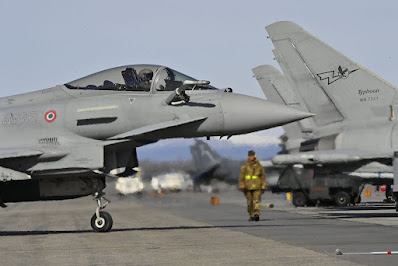Italian Air Force takes part in Red Flag-Alaska 24-1 advanced aerial combat exercise
 |
| Italian Air Force F-2000A Typhoon and KC-767A aircraft headed to Alaska to participate in the Red Flag-Alaska 24-1 exercise. |
Red Flag-Alaska 24-1, a USAF Pacific Air Forces-sponsored exercise, is currently underway at Eielson Air Force Base and Joint Base Elmendorf-Richardson, Alaska, with primary flight operations over the Joint Pacific Alaska Range Complex. It started on April 18 and is scheduled to run until May 3. Red Flag-Alaska is designed to provide realistic training in a simulated combat environment.
Approximately 2,000 service members and 60 aircraft are participating in this interaction of the exercise. The PACAF is participating with F-16C, KC-135, KC-130J, KC-46 and E-3 aircraft as well as tactical transport aircraft and helicopters. The US Marine Corps and US Navy have deployed AV-8N and EA-18G jets respectively. In addition to the U.S., the Italian Air Force sent 4 different types of aircraft to Alaska including Eurofighter and F-35A fighters, an E-550 CAEW (Conformal Airborne Early Warning) aircraft and a KC-767A tanker aircraft.
Approximately 2,000 service members and 60 aircraft are participating in this interaction of the exercise. The PACAF is participating with F-16C, KC-135, KC-130J, KC-46 and E-3 aircraft as well as tactical transport aircraft and helicopters. The US Marine Corps and US Navy have deployed AV-8N and EA-18G jets respectively. In addition to the U.S., the Italian Air Force sent 4 different types of aircraft to Alaska including Eurofighter and F-35A fighters, an E-550 CAEW (Conformal Airborne Early Warning) aircraft and a KC-767A tanker aircraft.
The Red Flag-Alaska, born under the name of Cope Thunder, and the Red Flag-Nellis exercises are designed to allow flight crews to train in advanced air combat, practicing extremely realistic missions and A2AD (Anti Access Area Denial) scenarios.
Italian and US pilots therefore have the opportunity to practice complex aerial missions, with over one hundred sorties per day, characterized by a high degree of difficulty, with the presence of Air-to-Air and Surface-to-Air-Missile (SAM) threats. These threats are integrated into a training scenario that allows participants to make the most of the potential of the various platforms and to replicate real situations.
Red Flag-Alaska participants are organized into defensive forces (Blue Air) and offensive forces (Adversary), which are used to train the Blue Air component. At the height of the exercise, up to 70 fighters can operate simultaneously in the same airspace.
The Italian fighter aircraft are expected to carry out both Air Interdiction missions and support missions for ground forces, as well as cooperating in missions to recover personnel in hostile territory.
Italian and US pilots therefore have the opportunity to practice complex aerial missions, with over one hundred sorties per day, characterized by a high degree of difficulty, with the presence of Air-to-Air and Surface-to-Air-Missile (SAM) threats. These threats are integrated into a training scenario that allows participants to make the most of the potential of the various platforms and to replicate real situations.
Red Flag-Alaska participants are organized into defensive forces (Blue Air) and offensive forces (Adversary), which are used to train the Blue Air component. At the height of the exercise, up to 70 fighters can operate simultaneously in the same airspace.
The Italian fighter aircraft are expected to carry out both Air Interdiction missions and support missions for ground forces, as well as cooperating in missions to recover personnel in hostile territory.
Written by Matteo Sanzani
Source, Images: Italian Air Force













No comments
All comments related to the contents of our articles are welcome. It is not allowed to post promotional messages, links to external sites, or references to activities not related to this blog.